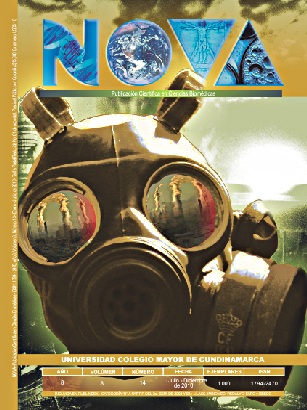Proteínas Cry de Bacillus thuringiensis y su interacción con coleópteros
Proteínas Cry de Bacillus thuringiensis y su interacción con coleópteros

NOVA por http://www.unicolmayor.edu.co/publicaciones/index.php/nova se distribuye bajo una Licencia Creative Commons Atribución-NoComercial-SinDerivar 4.0 Internacional.
Así mismo, los autores mantienen sus derechos de propiedad intelectual sobre los artículos.
Mostrar biografía de los autores
El Manejo Integrado de Plagas es un plan fundamental en la agricultura de conservación que armoniza los métodos químicos y biológicos afín de proteger los ecosistemas agrícolas y sus recursos naturales (agua, suelo, aire). El orden Coleóptera es uno de los problemas entomológicos más importante en los cultivos comerciales causando pérdidas de hasta 15%. Se utilizan estrategias de control de insectos tales como técnicas culturales, enemigos naturales, entomopatógenos y agentes químicos. Bacillus thuringiensis (Bt) es una bacteria entomopatógena ampliamente utilizada en el control de insectosplaga de los ordenes Lepidóptera, Coleóptera y Díptera. El factor de virulencia de Bt más importante son las proteínas Cry. Varias proteínas Cry tienen actividad letal contra los insectos coleópteros como Cry1B, Cry1I, Cry3, Cry7, Cry8, Cry9, Cry14, Cry22, Cry23, Cry34, Cry35, Cry36, Cry37, Cry43 y Cry55. Se ha encontrado que cepas de Bt tipo israelensis son activas contra coleópteros. En esta revisión nosotros presentamos los principales ítems relacionados con la actividad biológica de Bt sobre coleópteros-plaga.
Visitas del artículo 1128 | Visitas PDF 554
Descargas
- Environmental Protection Agency, EPA. 2002. Federal Insecticide,Fungicide, and Rodenticide Act (FIFRA) Inspection Manual.
- Chapter Two: Pesticide Law and Definitions. P. 22.
- Oerke E.-C. 2006. Crop losses to pests. Journal of Agricultural Science.144: 31–43.
- Krattiger A. F. 1997. Insect Resistance in Crops: A Case Study of Bacillus thuringiensis (Bt) and its Transfer to Developing Countries.
- ISAAA Briefs No. 2. Ithaca, New York: International Service for the Acquisition of Agrobiotech Applications. P. 42.
- Wang L, Wang S, Li Y, Paradesi MSR, Brown SJ (2007) BeetleBase: the model organism database for Tribolium castaneum. Nucleic Acids Res 35: D476–D479.
- Potter D.A., Powell A.J., Spicer P.G. et al. 1996. Cultural practices affect root-feeding white grubs (Coleoptera: Scarabaeidae) in turfgrass. J. Econ. Entomol. 89:156–164.
- Hill D. S. 1987. Agricultural insect pests of temperate regions and their control. Ed. Cambridge University Press. Cambridge UK, pp 258-437.
- Porcar, M. y V. Juárez-Pérez. 2004. Aislamiento y establecimiento de una colección de Bacillus thuringiensis. En Bacillus thuringiensis en el control biológico. Bravo, A. y Cerón, J. eds. Universidad Nacional de Colombia. Bogotá, Colombia. pp. 69-100.
- Roh JY, Choi JY, Li MS, Jin BR, Je YH. 2007. Bacillus thuringiensis as a Specific, Safe, and Effective Tool for Insect Pest Control. J. Microbiol. Biotechnol. 17: 547–559.
- Schnepf, E., Crickmore, N., Van Rie, J., Lereclus, D., Baum, J., Feitelson, J., Zeigler, D.R., Dean, D.H. 1998. Bacillus thuringiensis and Its Pesticidal Crystal Proteins. Microbiol. Mol. Biol. Rev. 62: 775-806.
- van Frankenhuyzen K. 2009. Insecticidal activity of Bacillus thuringiensis crystal proteins. J Invertebr Pathol. 101: 1-16.
- Sanchis V., Bourguet D. 2009. Bacillus thuringiensis: applications in agricultura and insect resistance management-a review. In Sustainable Agriculture. Lichtfouse et al. (eds.). Pp. 243-255.
- Cerón, J. 2004. Productos comerciales: nativos y recombinantes. En Bacillus thuringiensis en el control biológico. Bravo, A. y Cerón,
- J. eds. Universidad Nacional de Colombia. Bogotá, Colombia. pp. 123-147.
- Bale J. S., van Lenteren J. C. Bigler F. 2008. Biological control and sustainable food production. Phil. Trans. R. Soc. B. 363: 761–776.
- Crickmore, N., D. R. Zeigler, J. Feitelson, E. Schnepf, J. Van Rie, D. Lereclus, J. Baum, and D. H. Dean. 1998. Revision of the nomenclature for the Bacillus thuringiensis pesticidal crystal proteins. Microbiol. Mol. Biol. Rev. 62:807-813.
- López-Pazos y Cerón. 2007. Three-dimensional structure of Bacillus thuringiensis toxins: a review. Acta Biol. Colomb. 12: 19-32.
- Pigott C.R., Ellar D.J. 2007. Role of Receptors in Bacillus thuringiensis Crystal Toxin Activity. Microbiol. Mol. Biol. Rev. 71: 255–281.
- Aronson, A.I., and Y. Shai. 2001. Why Bacillus thuringiensis insecticidad toxins are so effective: unique features of their mode of action. FEMS Microbiology Letters. 195: 1-8.
- Bravo, A. 2004. Mecanismo de acción de las proteínas bioinsecticidas de Bacillus thuringiensis. En Bacillus thuringiensis en el control biológico. Bravo, A. y Cerón, J. eds. Universidad Nacional de Colombia. Bogotá, Colombia. pp. 69-100.
- Bravo A., Gill S.S., Soberón M. 2007. Mode of action of Bacillus thuringiensis Cry and Cyt toxins and their potential for insect control.
- Toxicon. 49: 423-435.
- Carroll J., Convents D., Van Damm J., Boets A., Van Rie J., Ellar D.J. 1997. Intramolecular proteolytic cleavage of Bacillus thuringiensis
- Cry3A δ-endotoxin may facilitate its coleopteran toxicity, J. Invertebr. Pathol. 70: 41- 49.
- Michaud D., Bernier-Vornais N., Overney S., Yelle S. 1995. Constitutive expression of digestive cysteine proteinase forms during development of the Colorado potato beetle, Leptinotarsa decemlineata Say (Coleoptera: Chrysomelidae). Insect. Biochem. Mol. Biol. 25: 1041–1048.
- Fabrick J., Oppert C., Lorenzen M.D., Morris K., Oppert B., Jurat-Fuentes J.L. 2009. A novel Tenebrio molitor cadherin is a functional receptor for Bacillus thuringiensis Cry3Aa toxin. J. Biol. Chem. 284: 18401-18410.
- Park Y., Abdullah M. A., Taylor M. D., Rahman K., Adang M.J. 2009. Enhancement of Bacillus thuringiensis Cry3Aa and Cry3Bb Toxicities to Coleopteran Larvae by a Toxin-Binding Fragment of an Insect Cadherin. Appl. Environ. Microbiol. 75: 3086-3092.
- Rausell C., García-Robles I., Sánchez J., Muñoz-Garay C., Martínez- Ramírez A.C., Real M.D., Bravo A. 2004. Role of toxin activation on binding and pore formation activity of the Bacillus thuringiensis Cry3 toxins in membranes of Leptinotarsa decemlineata (Say). Biochimica et
- Biophysica Acta. 1660: 99– 105.
- Martins E.S., Monnerat R.G., Queiroz P.R., Dumas V.F., Braz S.V., de Souza Aguiar R.W., Gomes A.C., Sánchez J., Bravo A., Ribeiro B.M. 2010. Midgut GPI-anchored proteins with alkaline phosphatase activity from the cotton boll weevil (Anthonomus grandis) are putative receptors for the Cry1B protein of Bacillus thuringiensis. Insect. Biochem. Mol. Biol. 40: 138-145.
- Ochoa-Campuzano C., Real M.D., Martinez-Ramirez A.C., Bravo A., Rausell C. 2007. An ADAM metalloprotease is a Cry3Aa Bacillus thuringiensis toxin receptor. Biochem. Biophys. Res. Comm. 362: 437-442.
- Crickmore, N., Zeigler, D.R., Schnepf, E., Van Rie, J., Lereclus, D., Baum, J, Bravo, A. and Dean, D.H. Febrero 12 de 2011. “Bacillus thuringiensis toxin nomenclature”. http://www.lifesci.sussex.ac.uk/Home/Neil_Crickmore/Bt/
- Bravo, A. 1997. Phylogenetic Relationships of Bacillus thuringiensis δ-endotoxin family proteins and their functional domains. J. Bacteriol.
- : 2793–2801.
- Méndez-López I., Basurto-Ríos R., Ibarra J. E. 2003. Bacillus thuringiensis serovar israelensis is highly toxic to the coffee berry borer, Hypothenemus hampei Ferr. (Coleoptera: Scolytidae). FEMS Microbiology Letters. 226: 73-77.
- Dale J. W., von Schantz M. 2002. From Genes to Genomes: Concepts and Applications of DNA Technology. John Wiley & Sons, Ltd. West sussex, England. P. 21-98.
- deMaagd R. A., Kwa M. S. G., van der Klei H., Yamamoto T., Schipper B., Vlak J. M., et al. 1996. Domain III substitution in Bacillus thuringiensis deltaendotoxin Cry1Ab results in superior toxicity for Spodoptera exigua and altered membrane protein recognition. Appl. Environ. Microbiol. 62:1537–1543.
- Pardo-López L., Muñoz-Garay C., Porta H., Rodríguez-Almazán C., Soberón M., Bravo A. 2009. Strategies to improve the insecticidal activity of Cry toxins from Bacillus thuringiensis. Peptides. 30: 589–595.
- Guo S., Ye S., Liu Y., Wei L., Xue J., Wu H., Song F., Zhang J., Wu X., Huang D., Rao Z. 2009. Crystal structure of Bacillus thuringiensis Cry8Ea1: An insecticidal toxin toxic to underground pests, the larvae of Holotrichia parallela. J. Struct. Biol. 168: 259-266.
- Yan G., Song F., Shu C., Liu J., Liu C., Huang D., Feng S., Zhang J. 2009. An engineered Bacillus thuringiensis strain with insecticidal activity against Scarabaeidae (Anomala corpulenta) and Chrysomelidae (Leptinotarsa decemlineata and Colaphellus bowringi). Biotechnol. Lett. 31: 697-703.
- Zhongkang W., Wei H., Guoxiong P., Yuxian X., Qiang L., Youping Y. 2008. Transformation and expression of specific insecticide gene Bt cry3A in resident endogenetic bacteria isolated from Apriona germari (Hope) larvae intestines. Wei Sheng Wu Xue Bao. 48: 1168-1174.
- Walters F.S., Stacy C.M., Lee M.K., Palekar N., Chen J.S. 2008. An engineered chymotrypsin/cathepsin G site in domain I renders Bacillus thuringiensis Cry3A active against Western corn rootworm larvae. Appl. Environ. Microbiol. 74: 367-374.
- López-Pazos S.A., Cortázar J.E., Cerón J.A. 2009. Cry1B and Cry3A are active against Hypothenemus hampei Ferrari (Coleoptera: Scolytidae). J Invertebr Pathol 101: 242-245.
- Naimov S., Dukiandjiev S., de Maagd R.A. 2003. A hybrid Bacillus thuringiensis delta-endotoxin gives resistance against a coleopteran and a lepidopteran pest in transgenic potato. Plant. Biotechnol. J. 1:51-57.
- Haffani Y.Z., Cloutier C., Belzile F.J. 2001. Bacillus thuringiensis Cry3Ca1 protein is toxic to the Colorado potato beetle, Leptinotarsa decemlineata (Say). Biotechnol. Prog. 17:211-216.
- Ben-Dov E., Boussiba S., Zaritsky A. 1995. Mosquito Larvicidal Activity of Escherichia coli with Combinations of Genes from Bacillus thuringiensis subsp. Israelensis. Journal of Bacteriology.177: 2851–2857.
- Soberón M., Gill S.S., Bravo A. 2009. Signaling versus punching hole: How do Bacillus thuringiensis toxins kill insect midgut cells? Cell. Mol. Life Sci. 66: 1337-1349.
- López-Pazos S.A., Martínez W., Castillo A.X., Cerón J. 2009. Presence and significance of Bacillus thuringiensis Cry proteins associated with the Andean weevil Premnotrypes vorax (Coleoptera: Curculionidae). Rev. Biol. Trop. 57: 1235-1243.
- Hernández, S., R. Andrew, Y. Bela & J. Ferré. 2005. Isolation and toxicity of Bacillus thuringiensis from potato-growing areas in Bolivia Carmen. J. Invertebr. Pathol. 88: 8-16.
- Loseva O., Ibrahim M., Candas M., Koller C. N., Bauer L. S., Bulla Jr L. 2002. Changes in protease activity and Cry3Aa toxin binding in the Colorado potato beetle: implications for insect resistance to Bacillus thuringiensis toxins. Insect Biochem. Mol. Biol. 32: 567–577.
- Forcada C., Alcacer E., Garcera M.D., Tato A., Martínez, R. 1999. Resistance to Bacillus thuringiensis Cry1Ac toxin in three strains of Heliothis virescens: proteolytic and SEM study of the larval midgut. Arch. Insect Biochem. Physiol. 42: 51–63.
- Hoffmann J. A., Kafatos F. C., Janeway C. A., Ezekowitz R.A.B. 1999. Phylogenetic perspectives in innate immunity. Science. 284: 1313–1317.
- Barillas-Mury C., Wizel B., Han Y.S. 2000. Mosquito immune responses and malaria transmission: lessons from insect model systems and implications for vertebrate innate immunity and vaccine development. Insect Biochem. Mol. Biol. 30: 429–442.
- Jiang H., Kanost M.R., 2000. The clip-domain family of serine proteinases in arthropods. Insect Biochem. Mol. Biol. 30: 95–105.
- Dimopoulos G., Richman A., Muller H., Kafatos, F.C. 1997. Molecular immune responses of the mosquito Anopheles gambiae to bacteria and malaria parasites. Proc. Natl. Acad. Sci. USA. 94: 11508–11513.
- Han Y. S., Thompson J., Kafatos F.C., Barillas-Mury C. 2000. Molecular interactions between Anopheles stephensi midgut cells and
- Plasmodium berghei: the time bomb theory of ookinete invasion of mosquitoes. EMBO J. 19: 6030–6040.
- Cristofoletti P.T., Terra W.R. 1999. Specificity, anchoring, and subsites in the active center of a microvillar aminopeptidase purified from Tenebrio molitor (Coleoptera) midgut cells. Insect Biochem. Mol. Biol. 29: 807–819.
- Cristofoletti P.T. Terra W.R. 2000. The role of amino acid residues in the active site of a midgut microvillar aminopeptidase from the beetle Tenebrio molitor. Biochem. Biophys. Acta. 1479: 185–195.
- Kaiser-Alexnat R. 2009. Protease activities in the midgut of Western corn rootworm (Diabrotica virgifera virgifera LeConte). J. Invertebr. Pathol. 100: 169–174.
- Bravo A, Soberón M. 2008. How to cope with insect resistance to Bt toxins? Trends Biotechnol. 26: 573-579.
- Hernández-Martínez, P., Naseri B., Navarro-Cerrillo G., Escriche B., Ferré J., Herrero S. 2010. Increase in midgut microbiota load induces an apparent immune priming and increases tolerance to Bacillus thuringiensis. Environmental Microbiology. 12: 2730-2737.
- Carty T. J., LoPresti-Morrow L. L., Mitchell P. G., McNiff P. A., McClure K. F. 1999. New Insights into Disintegrin Metalloproteases. Inflamm. res. 48: 229–231.
- -------------------------------------------------------------------------------
- DOI: http://dx.doi.org/10.22490/24629448.449





